Nephrostomy Catheter Care on Renal Compromised Patients
Nephrostomy Catheter Care on Renal Compromised Patients
Kidney disease is considered to be one of the most common health problems in modern society. According to Monga and Rane (2014), historical records show that there has been an impressive advancement in the management of this disease. Before the nephrostomy catheter, Haemodialysis (HD) was used from the early 1940s to the late 1980s (Newman, Rovner, & Wein, 2018). Recent statistics show that approximately 14% of Americans experience various stages of kidney failure. There is no specific geographical pattern on the prevalence of this disease. The paper focuses on the care and proper use of nephrostomy catheters on renal compromised patients. Nephrostomy Catheter Care on Renal Compromised Patients.
Background of the Problem
Renal disease, also known as kidney disease, is a condition that affects the normal functioning of kidneys. According to Davenport (2015), kidneys are responsible for filtering blood to remove wastes and excess water in the form of urine. These substances are toxic and should be excreted timely. The kidney eliminates them regularly in a process that Webb (2016) refers to as purification. Affected kidneys cannot perform the function of purification effectively.
According to Webb (2016), chronic kidney disease has become a common problem in the United States over the last century. Reduced physical activities, the increased popularity of unhealthy diets, and many other environmental factors have led to an increase in the number of those suffering from this condition. According to Davenport (2015), from 1988 to 1994, the prevalence of chronic kidney disease increased from 12% to 14% of the total American population. From 1999 to 2004, the rate reached above 15%. The statistics show that women are more vulnerable to this disease than men. Figure 1 below is a summary of the current rate of prevalence of the disease in the United States.
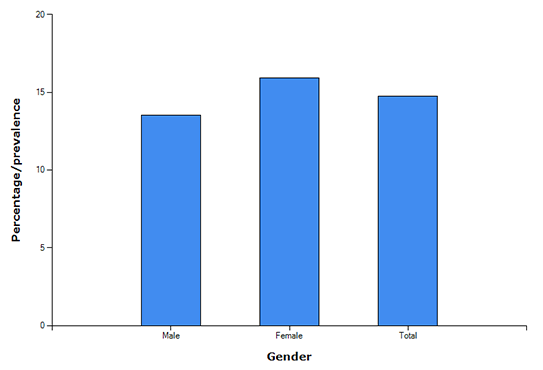
Chronic kidney disease goes through different stages before developing into kidney failure. Stage 1 is the kidney damage with a normal kidney function. At this stage, the kidney functions at 90% or a higher rate (Webb, 2016). It may not be easy for the patient to determine that he or she has a kidney problem. Stage 2 is associated with mild loss of the function of the kidney. Swelling of legs, abnormal urine tests, and infections of the urinary truck are common signs (Newman et al., 2018). Nephrostomy Catheter Care on Renal Compromised Patients.
ORDER A PLAGIARISM-FREE PAPER NOW
Kidney functions at 60-89% of the optimal rate. Stage 3 is the mild to moderate loss of function of the kidney (30-59%). Common characteristics of this disease at this stage are numbness of the body, unusual pain, and reduced mental sharpness.
According to Webb (2016), Stage 4 is associated with the severe loss of kidney function (15-29%). Some of the characteristics at this stage are anemia, abnormal blood levels of phosphorous, and decreased appetite (Newman et al., 2018). Stage 5, also known as end-stage renal disease, is a complete kidney failure that requires a transplant or regular dialysis (Webb, 2016). Some of the common characteristics include fatigue, uremia, vomiting, shortness of breath, swelling of limbs and eyes, and lower back pain.
Medical Devices Used in the Last Century for Renal Disease
Kidney disease is one of the medical conditions that have remained common within the last century. Once an individual has been diagnosed with renal disease, it is the responsibility of the medical team to manage the condition. The treatment approach and medical equipment changed with time and depend on the stage of the disease. According to Davenport (2015), one of the first portable devices used to manage kidney disease was Haemodialysis (HD).
The device was developed by Wilhem Kolff in the 1940s during the Second World War. Being in enemy territory, soldiers could not afford to get center-based dialysis. The medical staff had to develop mobile devices to help manage the condition of patients with kidney problems. The device was simple and less effective, but it was proved to be considerably useful during the period. In the 1960s, the device was enhanced in design to facilitate vascular access.
The current generation of portable dialysis devices has overcome two primary design issues. First, the gadget operates using small light battery-powered pumps that make them easily wearable and portable (Webb, 2016).Nephrostomy Catheter Care on Renal Compromised Patients. Secondly, these devices no longer rely on fresh dialysate as their predecessors because of the sorbent technology concept that makes it possible to reuse dialysate (Newman et al., 2018). The Vicenza wearable artificial kidney was a breakthrough in the management of kidney disease. Figure 2 below shows the principles of the device functioning.
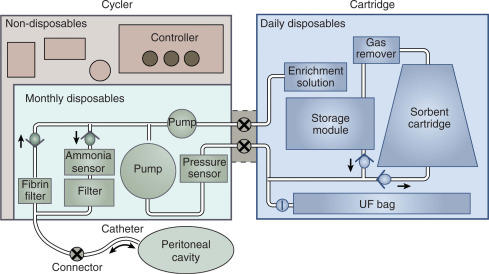
The use of catheters has become critical in the management of this condition. It makes it possible for them to lead normal lives despite their delicate condition. According to Webb (2016), care of catheters on renal compromised patients is of utmost importance for the wellbeing of patients with these types of devices. Ensuring that the devices are clean, unclogged, and capable of functioning properly is critical.
Davenport (2015) argues that nurses have the responsibility of explaining to the patients how to maintain these devices and when they should consider seeking medical attention. Webb (2016) explains that there are other medical catheters used to address similar renal compromised conditions. Foley’s catheters are inserted into the bladder to help in the drainage of urine. Davenport (2015) explains that Foley’s catheters can be used to drain urine directly from the kidneys in a procedure called percutaneous nephrostomy. Sometimes it may be necessary to use intravenous catheters to administer fluids and drugs among patients who cannot take them orally or through injection. Nephrostomy Catheter Care on Renal Compromised Patients.
Review and Summary of Relevant Literature
The previous section provided a detailed background of the issue under investigation. This section aims to provide a review and summary of the literature in this field. According to Bonjar and Bonjar (2015), when conducting a literature review, it is important to understand the goals of the study. The primary task of this project is to enhance patient lifestyle based on the care of nephrostomy catheters on renal compromised patients.
The study will identify the implications of poor care and maintenance of nephrostomy catheters on renal compromised patients. The concept of using catheters in managing renal problems is becoming increasingly popular both in developed and in developing nations (Center for Medicare and Medicaid Services, 2013). These portable devices have improved the lifestyle of patients with kidney diseases. Patients can use them without additional assistance after receiving instructions and proper training.
According to Davenport (2015), admitted patients receive regular attention of nurses and doctors who monitor their conditions to determine progress made. However, the outpatients may not have such attention. It may take a month or more before a catheter is replaced if it is functioning normally. Nephrostomy Catheter Care on Renal Compromised Patients. During this period, a patient will be expected to take good care of the instrument. In developed economies where the ratio of a nurse to patients is high, patients can afford to make regular phone calls to their assigned nurse in case they need their assistance (Pavord et al., 2017). However, patients in some of the developing nations do not have privileges. It makes it necessary to have models that can empower these patients to reduce their dependence on nurses.
Food and Drug Administration (FDA) has approved several devices over the last century to help deal with kidney problems. Haemodialysis (HD) was one of the devices invented in the 1940s and enhanced in the 1960s to make it possible for patients with this condition to spend several days before going for dialysis (Monga & Rane, 2014). Foley’s catheter emerged as a better version of HD and has since become very popular.
The catheter has enhanced functions and it is easier to use than the previous versions. Webb (2016) explains that one of the motivations behind the need to improve these devices is the requirement that patients should be able to utilize them effectively on their own. There is a desire to make patients with chronic conditions, the renal disease being one of them, more responsible in their health management.
According to Bonjar and Bonjar (2015), the number of people suffering from renal diseases is growing in the United States. In figure 4b below, it is evident that the number of people suffering from kidney-related complications is a small fraction of the total population. However, the problem is that the number has been growing consistently. Improper lifestyle with limited exercise and increased intake of unhealthy food can be considered the main reason.
Figure 3a shows that women under ten years and those over 90 years are least likely to develop renal problems. On the other hand, those aged 60 to 80 years are at the highest risk of developing kidney complications. Monga and Rane (2014) explain that while the risk of having a kidney-related disease increases, as one gets older, those who reach 90 years without developing the problem tend to have lower risks. Nephrostomy Catheter Care on Renal Compromised Patients.
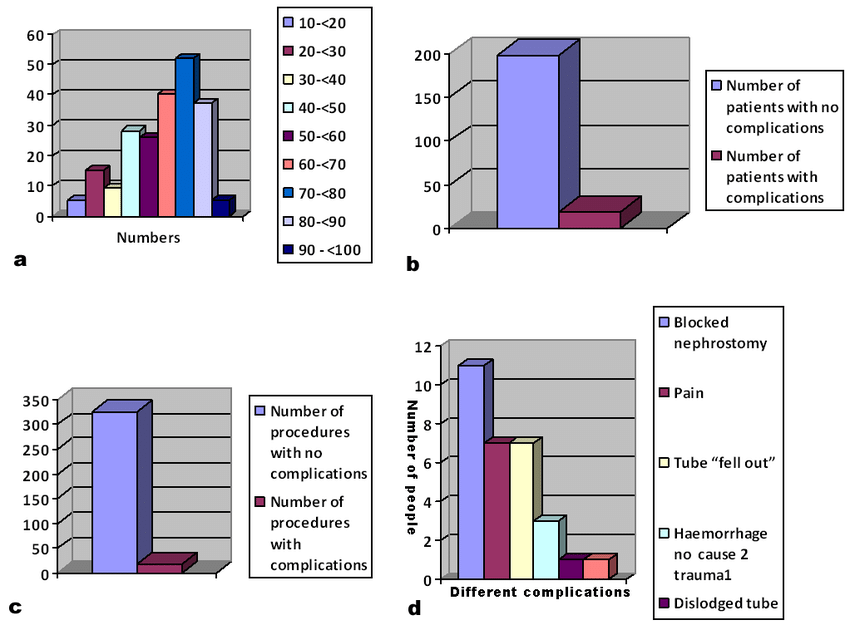
Advancement of technologies in the field of healthcare has made it easy for doctors to undertake various procedures such as the insertion of the catheter without any major complications. However, as Figure 3c shows, it does not mean that all risks during the procedures are eliminated. Although the number of procedures with complications is relatively lower than those that do not present any complications, there is a need to find ways of improving such processes (Center for Medicare and Medicaid Services, 2013). Scholars have been advocating for improved technologies that would assure patients that the procedure will be safe and painless, especially those with chronic conditions.
Monga and Rane (2014) identify several complications that may arise in the management of the nephrostomy catheter. One of the main complications is blocked nephrostomy, as shown in figure 3d above. The blockade can be caused by food particles, blood clots, or other dead cells in the tube. Cases of tube dislodgement will require urgent medical attention to eliminate accumulated substances in the kidney.
Bonjar and Bonjar (2015) explain that during such blockage, the patient may experience pain, especially if the accumulated waste cannot be eliminated from the body. Tube fell-out is another common problem when using a nephrostomy catheter to manage the condition. Poor physical handling of the catheter may result in the tube being not in the exact location where it should be. Such incidences are common in patients who are unaware of how they need to handle the catheter.
According to Monga and Rane (2014), a patient may consider removing the catheter without proper direction from the responsible medical staff. Such actions may lead to hemorrhage. The patient may suffer serious bacterial formation or other complications in such circumstances that may worsen their conditions. Nephrostomy Catheter Care on Renal Compromised Patients.These factors make it necessary to find effective ways of managing this condition.
Bonjar and Bonjar (2015) note that it is crucial to understand the current practices, possible weaknesses, and whether there are international best practices in this field, which are yet to be embraced locally. As Davenport (2015) devices, when planning to conduct qualitative research, adequate time should be dedicated to data collection. The process cannot be rushed since participants will be required to justify responses that they provide, especially if it is new information that may require elaboration.
During the period of collecting primary data, the researcher will analyze the literature on the topic. It will involve comparing information collected from primary sources with that in the existing literature. This approach will make it possible to determine if the local medical practitioners are embracing best practices. After collecting data, the researcher will need some time to compile the final report based on information collected from participants and data collected from secondary sources.
The concept of self-care has received the attention of scholars and medical practitioners over the recent past. Studies have found that involving patients in managing their condition is one of the ways of improving their recovery level (Center for Medicare and Medicaid Services, 2013).
The strong will to overcome the medical condition pushes them to embrace a new lifestyle that is needed in managing their delicate condition. The concept of self-care is crucial for patients with chronic kidney disease who using a nephrostomy catheter. Therefore, hospitals in the United States have been working on ways of promoting it. As discussed above, poor management of the catheter may have serious consequences for a patient. Appropriate models have been proposed by scholars such as Chan et al. (2018) to help solve the problem. Nephrostomy Catheter Care on Renal Compromised Patients.
Statement of the Problem
Renal compromised patients need nephrostomy catheters to help in eliminating blockage in the urinary system. The necessity to utilize the nephrostomy catheter must be confirmed by responsible medical personnel. The reasons for use of the catheter are the injured ureter blockage that cannot be bypass (Webb, 2016). One of the benefits of this catheter is that it allows the patient to lead a normal life as a healthy person while a lasting solution for the condition is sought.
Wastes within the kidney will be drained normally when one has the catheter. However, one of the main disadvantages of the nephrostomy catheter is that the patient may have difficulties with proper maintenance of the device. As shown in Figure 4 below, the catheter may protrude out of the body from the kidney before it is inserted back to the bladder. In other cases, the urine may be collected in a bag. Whichever approach the doctor uses to insert the catheter, poor care, and maintenance of nephrostomy catheters on renal compromised patients may have serious implications.
Davenport (2015) explains that these catheters may become serious points of bacterial infection. When the patient fails to maintain high levels of hygiene, the bacterial infection may have a serious effect on internal body organs. Another danger is that poor physical handling of the catheter may result in physical damage to the kidney and bladder. Nephrostomy Catheter Care on Renal Compromised Patients. As shown in figure 4 below, the tubes are physically attached to these organs. A minor accident in the house or on-road may have serious health implications for the patient. As such, it is critical to ensure that the catheter is handled properly. The patient should be educated on how to take care of the device and what actions should be taken in case its effectiveness has been compromised.
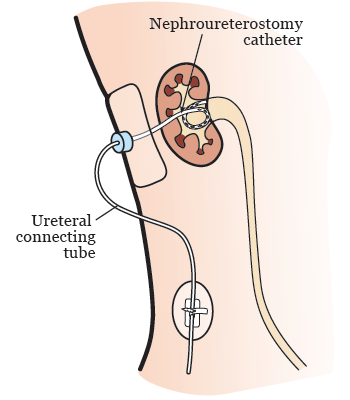
Purpose of the Project
The primary purpose of this project is to enhance renal compromised patients’ lifestyles based on proper care of nephrostomy catheters. These patients rely on the catheter to ensure that they can follow a pain-free lifestyle and avoid other health complications. Davenport (2015) explains that depending on the cause of kidney disease, it is possible to find a cure for the complication. During the period of treatment, such an individual may need to use the catheter to help in eliminating wastes from the body.
Patients suffering from chronic kidney disease may need to use the catheter for a longer period. Medical follow-ups that may improve the quality of life of renal compromised patients may be unavoidable during the period of treatment. It is critical to ensure that the catheter is functioning normally and that the patient is not subjected to any intense pain or other complications common for their condition.
The project will outline the ways nurses can help these patients to maintain the device to enhance its functionality. Newman et al. (2018) argue that nursing policies on care of nephrostomy catheters need to be reviewed to make nurses more responsible for managing the conditions of these patients. Understanding the care of nephrostomy catheters is a fundamental step towards enhancing the lifestyle of renal compromised patients.
Frequent replacement of the catheter may further compromise the functionality of the kidney (Webb, 2016). However, that may be unavoidable if the patient fails to understand and follow instructions given by the doctor. The issue is rather acute among outpatients who may not be under regular observation of medical staff. Therefore, sensitizing them on the effective use of this instrument is critical. Nephrostomy Catheter Care on Renal Compromised Patients.
Significance of the Project
Renal disease is considered a major health problem not only in the United States but also in other parts of the world. According to Davenport (2015), over 661,000 Americans suffer from kidney failure. A larger number is undergoing the initial stages of renal disease. Another group is still not aware of their medical condition. The significance of this project is that it seeks to find a way of helping these patients to lead pain-free lives. The justification of the study is that it will help medical practitioners to have a better understanding of the ways of helping renal disease patients maintain catheters. The study will make significant contributions in this field by identifying the current practices and ways in which they can be improved based on new research and technology.
Managing kidney disease may need close coordination of the local and global health experts to find ways of addressing the issue. The project is considered unique, as it observes not only the practices that have been embraced locally within the United States but also the successful outcomes in other countries. Upon its completion, it will provide a source of reference to the local medical practitioners on the best practices that have been embraced in other developed economies.
The knowledge that will be achieved through the study will allow local doctors and nurses to understand the ways of addressing various challenges that they face when handling a renal disease patient. As Webb (2016) notes, identifying local weaknesses is a major step in improving local practices. The study will also be beneficial to medical researchers who may want to conduct further investigation on the use of nephrostomy catheters on renal compromised patients.
Nature, Scope, and Limitations of the Project
Nature
The researcher intends to use qualitative methods in this investigation. Quantitative studies have been conducted in this field to determine the level of prevalence of the renal disease in the United States and other parts of the world and the effectiveness of various instruments used to manage the condition. In this qualitative method, the goal will be to explain the importance of proper care and maintenance of the catheters. It will identify weaknesses that exist in the current practice and the ways they can be addressed to enhance the effective management of this complication (Davenport, 2015).
Explaining the facts requires a detailed explanation to every question posed to the respondents. Qualitative research design eliminates the restriction that requires respondents to agree or disagree with specific statements.Nephrostomy Catheter Care on Renal Compromised Patients. Instead, it allows them an opportunity to explain their views in their own words based on personal experiences and knowledge gained in this field. The design will make it possible to identify varying challenges and different approaches that can be used to overcome them. The chosen design is the most appropriate approach that will help to accomplish the goals of the study.
Scope of the Project
The study focuses on the importance of proper maintenance and care of the nephrostomy catheter on renal compromised patients in local hospitals. Other methods of managing this complication, though being effective, are out of the scope of the study. Participants in this study will include renal doctors, nurses, and patients with renal problems within the local hospital. When selecting participants in each of the three groups, the main factor that will be considered is the accessibility of the population. It will be crucial to ensure that individuals selected to participate in the project are available.
Cases with an individual failing to turn up for the interview as planned will be avoided, as they may compromise the quality of this study. The appropriate setting for gathering data will be in the interventional radiology patients’ section in participating hospitals. The reason for the department being selected is that the researcher will be assured of having access to individuals who meet the set criteria (patients with renal problems, doctors, and nurses who specialize in this field).
The researcher intends to need four months to complete the project. Three and a half weeks will be dedicated to the process of data collection. It will involve interviewing the participants and visiting the local hospitals to monitor how patients are managed. The rest of the time will involve compiling the report.
Limitations of the Project
Identifying various limitations, as Davenport (2015) notes, makes it possible to identify the most effective ways of addressing them to enhance the usefulness of the results. One of the main limitations of qualitative research design is the time required to conduct research. Unlike quantitative methods that require respondents to give yes/no answers to specific questions, qualitative research requires them to provide a detailed explanation for every response they give.
ORDER A PLAGIARISM-FREE PAPER NOW
It implies collecting primary data requiring rather much time when using the design than would be the case when using quantitative methods. Another limitation that is expected is access to certain individuals who may provide the information needed. Some of the renal doctors may not have time to take part in the study. Another issue would be the inaccessibility of certain records, organizational units, and data that may inform the study. Nephrostomy Catheter Care on Renal Compromised Patients.
Theoretical Framework
The theoretical framework should help to evaluate relationships among variables while setting limits (Webb, 2016). The selected theoretical framework is Dorothea Orem’s self-care deficit nursing theory. The theoretical framework was chosen due to its thorough grasp of critical issues, perspectives, and controversies in the field under examination, as they relate to the project at hand, indicating where the current project fits within this logical landscape.
This theory holds the belief that when patients are assigned major roles in managing their condition, they tend to feel more responsible than when the relevant doctor or nurse is completely in charge. The theory is based on the philosophy that patients tend to desire to take care of themselves as much as possible (Newman et al., 2018). Unfortunately, they are rarely given this opportunity due to the policies embraced by most of the healthcare institutions.
The theory seeks to promote self-care among patients suffering from chronic conditions. According to Davenport (2015), chronic kidney disease and stroke are health complications that require the proper participation of patients.
They need to understand the required steps to be taken at a given time to help improve their condition. The theory holds that when a patient cannot meet personal self-care requisites, a self-care deficit will occur (Webb, 2016). Self-care deficit is a state where the patient feels that he or she is helpless in managing the condition. The conceptual framework in figure 5 below shows how this model can be used to manage stroke.
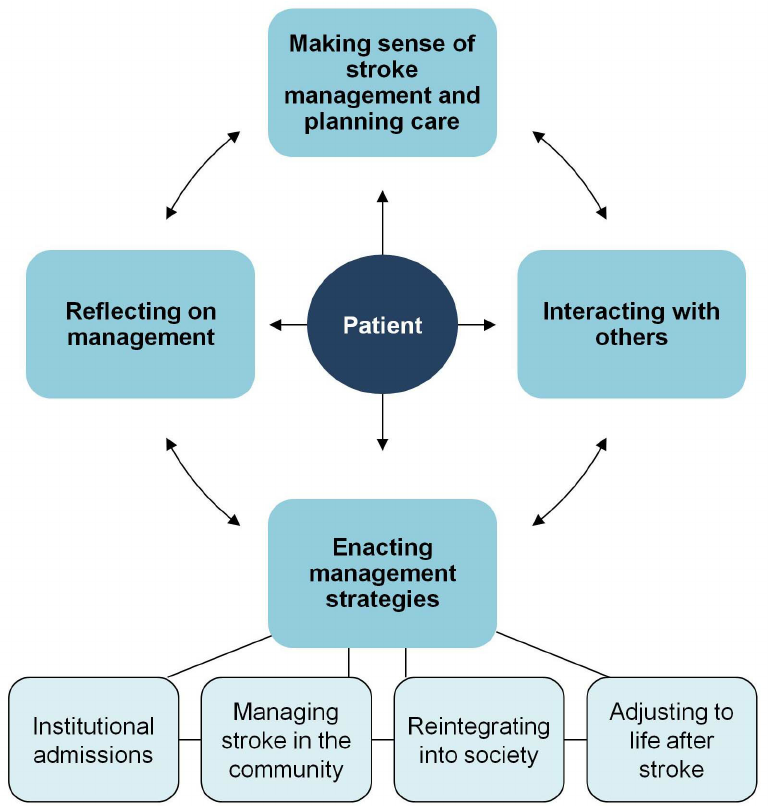
The model shown in figure 5 above can effectively be used when managing a renal compromised patient when using a nephrostomy catheter. As shown in the figure, it starts with making sense of the condition and the appropriate management plan.
The doctor and nurse can develop a model of management based on the cases that they are handling within a given facility. The next step is the interaction with the patients to explain the model and how they can have a critical role in managing their condition. Other than explaining to them the steps that they should take to manage the catheter, they may also need information concerning diet and physical activities they should avoid because of the catheter (Davenport, 2015).
As soon as an agreement between the medical staff and the patient is reached, the proposed strategies should be enacted. Patients will be required to maintain close communication with their assigned nurses in case they need clarification. Instead of coming to the hospital, they can make phone calls and get clarification on possible issues. The final stage involves reflection on the management plan. The team will review the effectiveness of the plan and areas that need improvement. The goal is to ensure that patients can take proper care of catheters, especially those who are not admitted, to avoid infection and other complications related to poor management of this device. Nephrostomy Catheter Care on Renal Compromised Patients.
Summary
The use of nephrostomy catheters in managing the condition of renal compromised patients appears to be a popular practice in modern healthcare institutions. The instrument enables these patients to follow pain-free lifestyles without having to make frequent visits to hospitals for dialysis. As shown in this paper, proper management and care of nephrostomy catheters are critical in enhancing their functionality. The study shows when the catheter is not maintained hygienically, it may cause bacterial infection in internal organs. Poor physical handling of the tubes may also cause injury to the kidney. The study explains the ways of enhancing the proper management of the nephrostomy catheter.
References
Bonjar, M. S., & Bonjar, L. S. (2015). Design of a new therapy for patients with chronic kidney disease: Use of microarrays for selective hemoadsorption of uremic wastes and toxins to improve homeostasis. Drug Design Development and Therapy, 9(1), 625-629.
Center for Medicare and Medicaid Services. (2013). End-stage renal disease (ESRD). Web.
Chan, C. T., Wallace, E., Golper, T. A., Rosner, M. H., Seshasai, R. K., Glickman, J. D., & Schreiber, M. (2018). Exploring barriers and potential solutions in home dialysis: An NKF-KDOQI conference outcomes report. American Journal of Kidney Disease, 20(20), 1-7. Web. Nephrostomy Catheter Care on Renal Compromised Patients.
Davenport, A. (2015). Portable and wearable dialysis devices for the treatment of patients with end-stage kidney failure: Wishful thinking or just over the horizon? Pediatric Nephrology, 30(12), 2053-2060.
Monga, M., & Rane, A. (2014). Percutaneous renal surgery. Chichester, UK: John Wiley & Sons Limited.
Newman, D. K., Rovner, E. S., & Wein, A. J. (2018). Clinical application of urologic catheters, devices and products. Cham, Switzerland: Springer.
Pavord, I. D., Chanez, P., Criner, G. J., Kerstjens, H. M., Korn, S., Lugogo, N., & Martinot, J. (2017). Mepolizumab for eosinophilic chronic obstructive pulmonary disease. The New England Journal of Medicine, 377(1), 1613-1629. Web.
Webb, D. R. (2016). Percutaneous renal surgery: A practical clinical handbook. Cham, Switzerland: Springer. Nephrostomy Catheter Care on Renal Compromised Patients.
